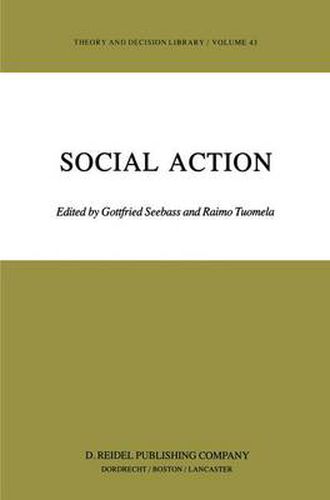Readings Newsletter
Become a Readings Member to make your shopping experience even easier.
Sign in or sign up for free!
You’re not far away from qualifying for FREE standard shipping within Australia
You’ve qualified for FREE standard shipping within Australia
The cart is loading…






This title is printed to order. This book may have been self-published. If so, we cannot guarantee the quality of the content. In the main most books will have gone through the editing process however some may not. We therefore suggest that you be aware of this before ordering this book. If in doubt check either the author or publisher’s details as we are unable to accept any returns unless they are faulty. Please contact us if you have any questions.
The papers contained in this volume are based on the contributions to an international, interdisciplinary Symposium entitled ‘Analytical and Sociologi cal Action Theories’ which took place in Berlin (West) on September 1-3, 1982. Each part comprises a main paper followed by two (in Part IV three) papers commenting on it. On the whole there is an equal division into philo sophical and sociological papers. In particular each main paper receives both inter- and innerdisciplinary comments. The Berlin Symposium was supported by the Deutsche Forschungsgemeinschaft (Bonn) and, to a smaller extent, by the Freie UniversiHit Berlin; both grants are acknowledged gratefully. Berlin and Helsinki, May 1984 GOTTFRIED SEEBASS RAIMO TUOMELA vii GOTTFRIED SEEBASS INTRODUCTION I. It is a striking fact that the extended efforts of both sociologists and analytical philosophers to work out what is termed a ‘theory of action’ have taken little, if any, account of each other. Yet of the various reasons for this that come to mind none appears to be such as to foil any hopes for fruitful interdisciplinary exchange. Being concerned, apparently, with the same set of phenomena, viz. individual and social actions, the two theories can reasonably be expected to be partially overlapping as well as competitive and complementary. Accordingly each can eventually be shown by the other to need completion or revision. Whether or to what extent this is the case is subject to inquiry and discussion.
$9.00 standard shipping within Australia
FREE standard shipping within Australia for orders over $100.00
Express & International shipping calculated at checkout
This title is printed to order. This book may have been self-published. If so, we cannot guarantee the quality of the content. In the main most books will have gone through the editing process however some may not. We therefore suggest that you be aware of this before ordering this book. If in doubt check either the author or publisher’s details as we are unable to accept any returns unless they are faulty. Please contact us if you have any questions.
The papers contained in this volume are based on the contributions to an international, interdisciplinary Symposium entitled ‘Analytical and Sociologi cal Action Theories’ which took place in Berlin (West) on September 1-3, 1982. Each part comprises a main paper followed by two (in Part IV three) papers commenting on it. On the whole there is an equal division into philo sophical and sociological papers. In particular each main paper receives both inter- and innerdisciplinary comments. The Berlin Symposium was supported by the Deutsche Forschungsgemeinschaft (Bonn) and, to a smaller extent, by the Freie UniversiHit Berlin; both grants are acknowledged gratefully. Berlin and Helsinki, May 1984 GOTTFRIED SEEBASS RAIMO TUOMELA vii GOTTFRIED SEEBASS INTRODUCTION I. It is a striking fact that the extended efforts of both sociologists and analytical philosophers to work out what is termed a ‘theory of action’ have taken little, if any, account of each other. Yet of the various reasons for this that come to mind none appears to be such as to foil any hopes for fruitful interdisciplinary exchange. Being concerned, apparently, with the same set of phenomena, viz. individual and social actions, the two theories can reasonably be expected to be partially overlapping as well as competitive and complementary. Accordingly each can eventually be shown by the other to need completion or revision. Whether or to what extent this is the case is subject to inquiry and discussion.